The Customer/Supplier + Item view allows you to define a price and discount for a specific item and for a specific customer or supplier.
Header of the Customer/Supplier + Item view
Available fields/parameters include:
- Price list (required) – it allows you to enter a price list’s identification. It can consists of up to 15 characters, including letters, digits, and some special characters (dot, hyphen). The field is editable until you save changes.
- Validity period (required) – the field is divided into two parts: in the first one, enter the beginning of the validity period, and in the second – the end. You may either enter them manually or use the calendar icon.
If the validity period is no longer effective, you can change it only with the [Accept validity period] action. - Description (required) – it is an additional description of the price list
- Currency (required) – it is the currency to be used when presenting prices of items included in the price list.
The field is editable until the price list is assigned to a price listing. - Price list category – use the drop-down list in this field to determine the price list’s category. The field is editable until the price list is assigned to a price listing. Available options include:
- Standard
- Sales promotion
- Standard price list (activated after selecting Sales promotion in the Price list category field) – it allows you to select a standard price list to which the promotional price list should refer
- Classification – it makes it possible to classify the price list according to a sales/purchasing price list classification defined in the Classifications application. The classification can be selected from the list under the [Value assistant] button.
- Accept validity period – activate this parameter to assign the validity period from the header to all items assigned to the price list. Leave this parameter deactivated to allow defining a separate validity period for each item.
- Customer/Supplier – depending on the price list type, this field allows you to select a customer or supplier to enter special item prices for. If you are editing a price list, select a customer/supplier whose prices you want to display in the application view. The list of customers/suppliers (that is partners with the Customer or Supplier role) is available under the [Value assistant] button.
- End consumer prices (only available for sales price lists) – activate this parameter to define a price list for retail customers (B2C). If you leave this parameter deactivated, the price list will be used for organizations (B2B clients).
If the parameter is activated, an additional column will be displayed on the list of line items: Base price.
Once you assign the sales price list to a sales price listing, it will no longer be possible to change the parameter’s setting.
Line items in the Customer/Supplier + Item view
The list of line items displays price information grouped for separate items. Available columns include:
- Price category (non-editable) – it displays a price category as a symbol depending on the selected price component
- Item (non-editable) – it displays a sales/purchasing item to which a given price or discount/surcharge is applicable
- Scale – it displays a scale from which the price or discount/surcharge applies
- Price component type – it displays a selected price component type applicable to a line item
- Quantity, price, percent – depending on the selected price component type, this field displays either a price with a currency or the percent/amount of a discount/surcharge (with a currency)
- Dimension – it displays the price dimension of a given item. It must be defined for price list line items of the Price category.
- Base price (available in sales price lists if the End consumer prices parameter has been selected in the header) – it displays the base price calculated according to data entered for a given item in the Items application’s Base view on the Base price tab
- Discount item – it displays a freebie (if one has been added)
- Valid from – it displays the date from which a given price component is effective
- Valid from – it displays the date to which a given price component is effective
You can also select the [Change information] button to see additional columns:
- Last changed by (non-editable) – it displays the identification and name of a user who last entered some changes
- Last change time (non-editable) – it displays the date and time of the last modification of a line item
Line item editor in the Customer/Supplier + Item view
The Customer/Supplier + Item view contains different fields, depending on the selected price component type to be assigned.
Price/Undisclosed price difference
The button allows you to assign a price/undisclosed price difference of the Price category to an item, dedicated to a specific customer or supplier.
Once you select the button, the following fields become available:
- Item (required) – it allows you to select an item to which the price applies in the context of a selected (customer or supplier) price classification. The list of available sales/purchasing items is available under the [Value assistant] button. The field is editable until you save changes.
- Scale – it is used to define the quantity of an item from which the price should be applicable. The field is divided into two parts: enter the item quantity in the first part, and a unit in the second part. The unit must match the unit of the item or packaging.
If you do not enter any scale (and it has the value of 0), the total price of the ordered item will be the defined price per item unit multiplied by the item quantity.
- Price component type (required) – use this field to define a price component type that includes the price’s category (Price or Undisclosed price difference). The list of types is available under the [Value assistant] button.
- Price – in this field, you can enter a price in a currency retrieved from the application header
- Price dimension (required) – it allows you to define for how many item units the price should be applicable. The field is divided into two parts: in the first one, you can use a drop-down list to select the number of units for which the price should be used. It contains values that are successive powers of the number 10. In the second part, you can define the unit for the price dimension. Units can be selected from the list under the [Value assistant] button.
- Validity period (available and required if the Accept validity period parameter in the header is deactivated) – in the first part of the field, specify the start of the price validity period for the item, and in the second part – the period’s end. You can either enter the dates manually or select them from the calendar in the field. If you do not fill in the field, it will accept the price list’s validity period value.
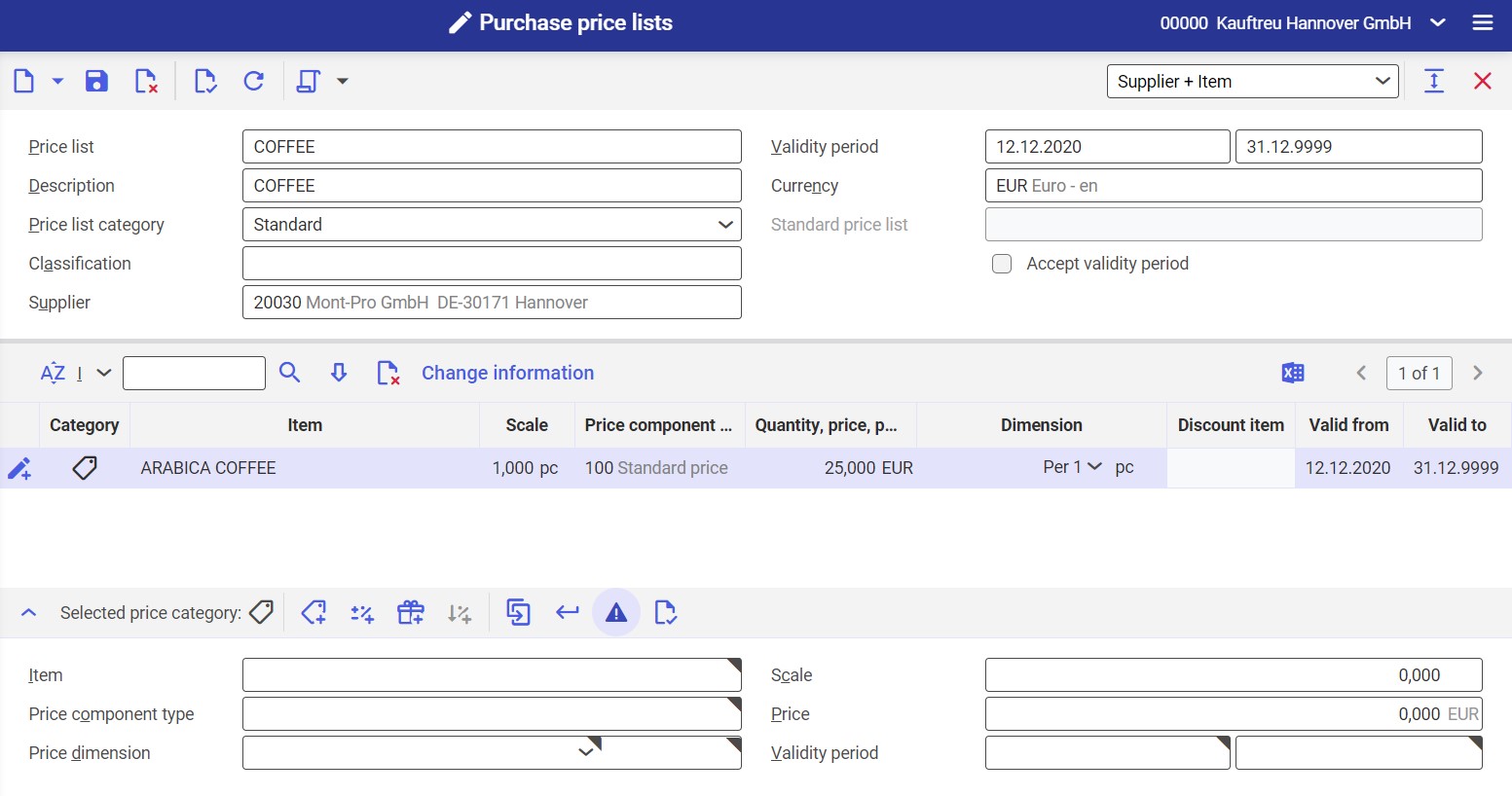
The purchase price list in this example specifies that one piece of item ARABICA COFFEE from supplier 20030 is to have the special price of 25 EUR. Using a different supplier or different item in a purchase order will not apply the special price.
Surcharge/Discount
The button allows you to define a amount- or quantity-based discount or surcharge for an item, depending on a quantity or value scale. Available fields include:
- Item (required) – it allows you to select an item to which the discount/surcharge applies in the context of a selected customer or supplier. The list of available sales/purchasing items is available under the [Value assistant] button.
- Scale – it is used to define the quantity/amount of an item from which the price should be applicable. The field is divided into two parts: enter the item quantity or amount in the first part, and a unit or currency in the second part.
- Price component type (required) – in this field, you can enter a price component type (of the Discount or Surcharge category) with an appropriate usage (e.g. only for line items or for header and line items)
- Amount, percent – the field is divided into two parts. In the first part, enter a numeric value, while in the second part, either the percent symbol (if the discount/surcharge is percentage-based) or currency (if the discount/surcharge is amount-based).
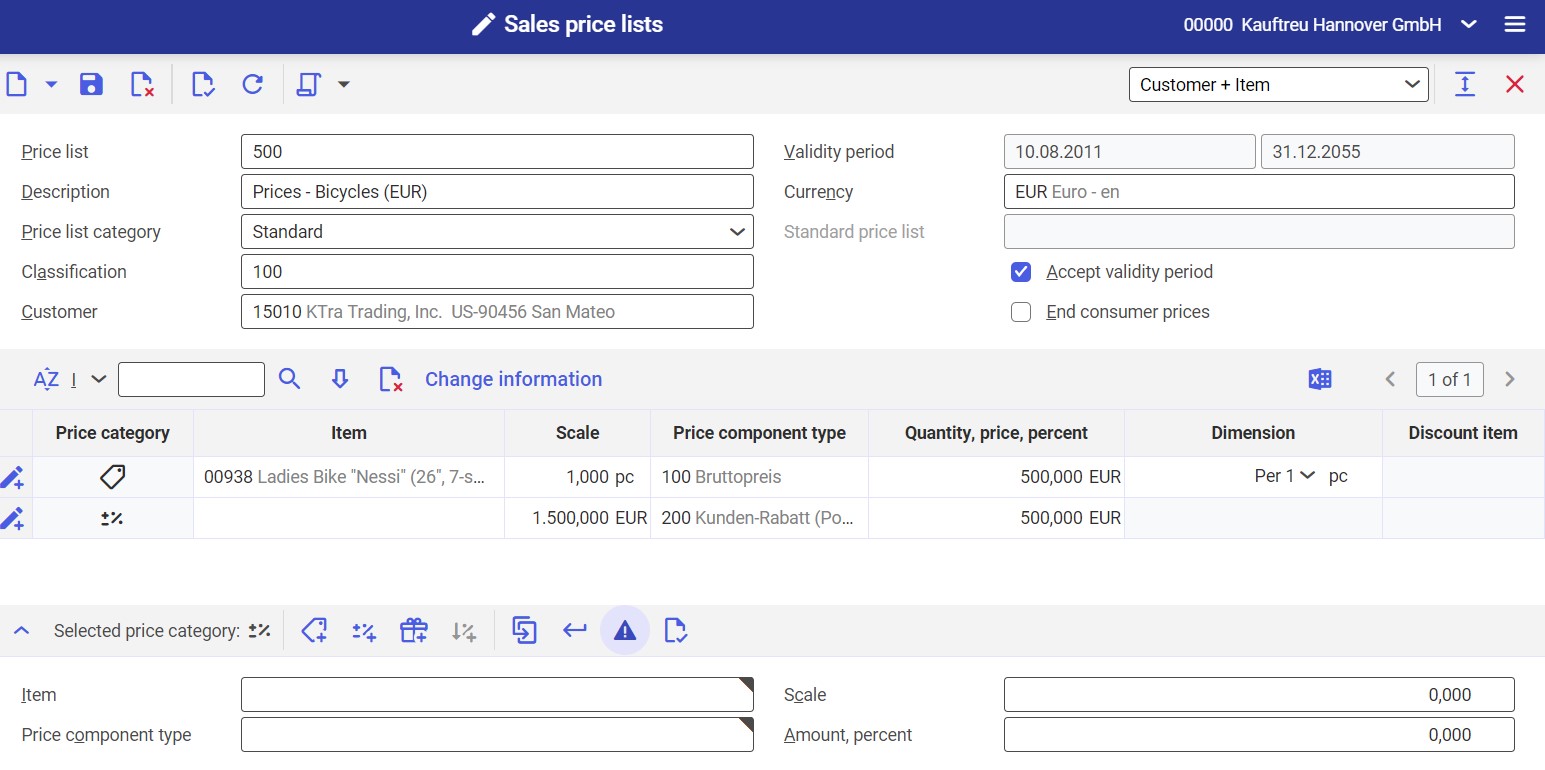
See the correct configuration of a sales price list with item Ladies bike “Nessi”, allowing the system to automatically apply a 500 EUR discount for a specific customer (15010) in transactions over 1,500 EUR.
The item has been entered twice in the Customer + Item view. The first time, the scale has been set to 1 piece and the price component type Price/Undisclosed price difference has been used. In the second line, the same item has been entered with the scale of 1,500 EUR, which means that a discount (since a price component of the type Discount has been used) of 500 EUR will be applied for the customer when this amount is exceeded.
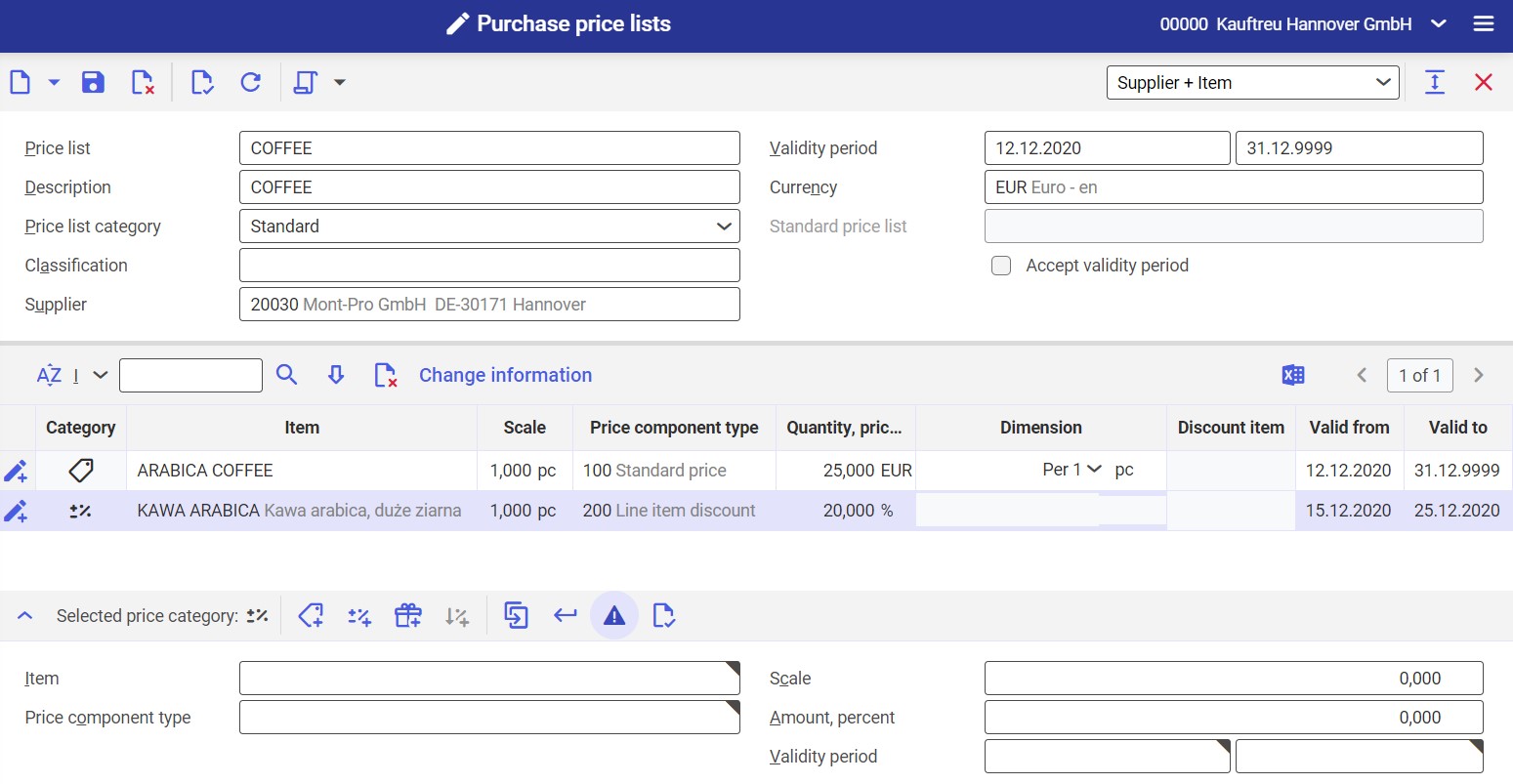
The purchase price list in this example specifies that the base price of item ARABICA COFFEE for supplier 20030 is 25 EUR per piece. As an exception, there should be a 20% discount on this item from 15.12.2020 to 25.12.2020 for this supplier.
In the first line, the base price for the supplier has been entered using the [Price] button. In the second line, the discount has been entered using the [Surcharge/discount] button.
Discount in kind
A discount in kind allows you to add a freebie or discount to an item if certain conditions are met (e.g. two pieces of the main item are ordered).
Fields available after selecting this type of discount include:
- Item (required) – it allows you to select an item to which the freebie will be added in the context of a selected customer. The list of available sales/purchasing items is available under the [Value assistant] button.
- Scale – it is used to define the quantity of the main item from which the freebie should be offered. The field is divided into two parts: enter the item quantity in the first part, and a unit in the second part. The unit must match the unit of the item.
- Price component type (required) – in this field, you can enter a price component type for the item (you can select a discount or surcharge)
You must specify an amount-based surcharge for a purchase price component type Surcharge that has the option Assign completely to the first partial delivery selected in the Surcharge distribution for partial deliveries field (in the Purchase price component types application).
- Quantity, percent – the field is divided into two parts. If you enter a number in the first part and an item unit in the second part, this quantity will reflect the quantity of freebie units that will be added to an order after meeting appropriate conditions. In turn, if you enter an amount in the first part and a currency in the second part, it will be the discount/surcharge applied for the main item and a freebie item will not be added to an order. Also, if you enter a percentage value in this field and select a freebie in the Discount item field, the freebie will be added as a percent of the main item.
- Discount item – in this field, select a freebie item to be added to an order containing the main item, provided that appropriate conditions defined in the price list are met. The item will not be added if an amount or percentage is entered in the Quantity, percent field.
- Round – this field allows you to determine the method of rounding quantities for the discount in kind. The field is divided into two parts; in the first part, select an appropriate option:
- No rounding – the quantity will not be rounded
- Round up – the quantity will be rounded up
- Round down – the quantity will be rounded down
- Commercial rounding – the quantity will be rounded mathematically
Afterwards, unless you select No rounding, you will be able to determine the number to which the percentage quantity will be rounded.
If you enter the value of 10% as the scale and set the Round field as Round up 1, the customer will receive 2 pieces free when purchasing 11 items.
- Validity period (required if the Accept validity period parameter in the header is deactivated) – in the first part of the field, specify the start of the price validity period for the item, and in the second part – the period’s end. You can either enter the dates manually or select them from the calendar in the field.
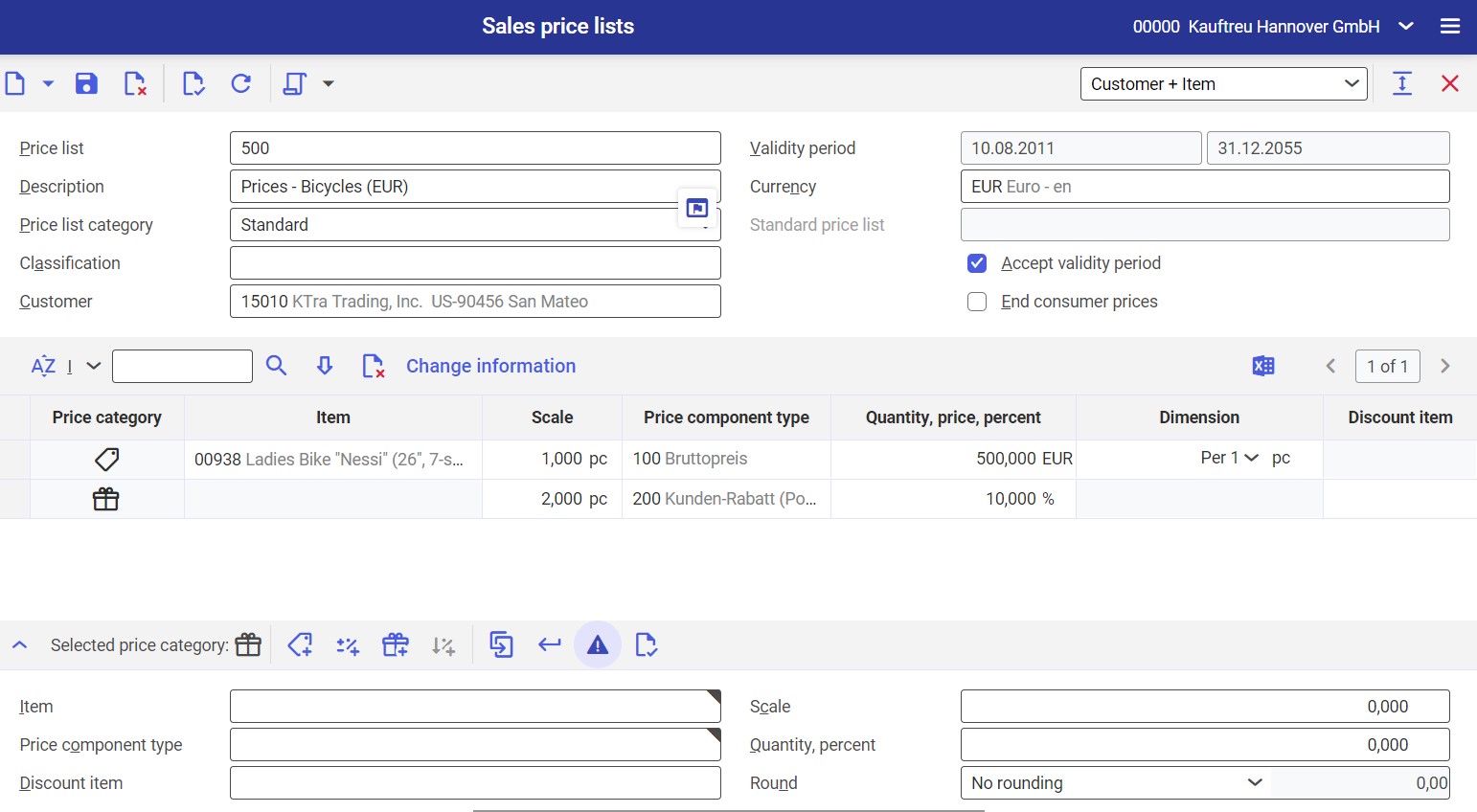
See the correct configuration of a sales price list with item Ladies bike “Nessi”, allowing the system to automatically apply a 10% discount when two or more pieces are sold.
The item has been entered twice in the Customer + Item view: the first line uses the price component type Price/Undisclosed price difference and the scale of 1 piece, while the second uses the Discount type and the scale of 2 pieces.
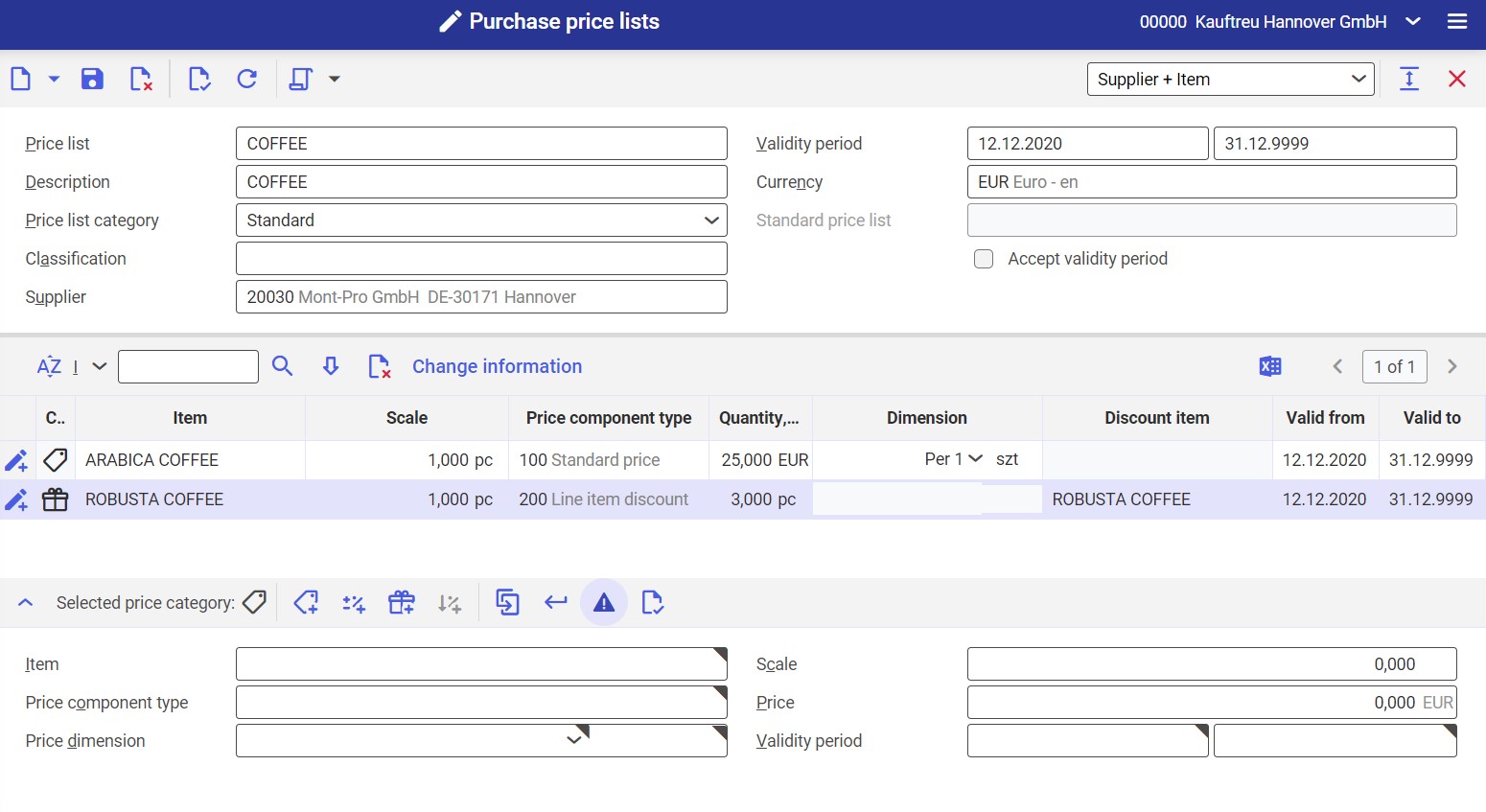
The purchase price list in this example specifies that the base price of item ARABICA COFFEE for supplier 20030 is 25 EUR per piece. Additionally, if one or more pieces are purchased, the supplier will receive a freebie – 3 pieces of a ROBUSTA COFFEE item.
In the first line, the base price of the item has been entered using the [Price] button. The discount in kind has been applied using the [Discount in kind] button.


